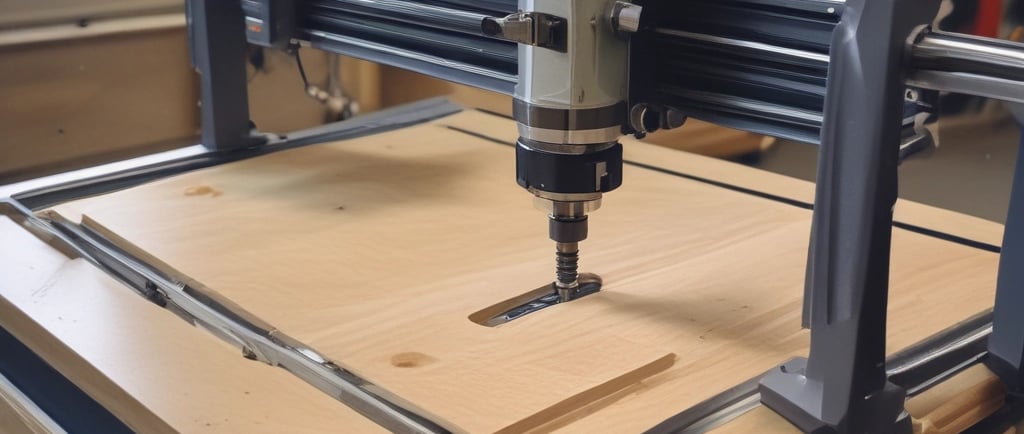Precision Cutting and Quality Assurance in CNC Router Operations
8/4/20254 min read


Understanding CNC Routers: The Basics
CNC routers, or Computer Numerical Control routers, are sophisticated machines utilized in various industries for the precise cutting, shaping, and engraving of materials. The fundamental principle of a CNC router lies in its ability to translate digital designs into physical objects through an automated process. By employing computer-generated codes, these machines execute precise movements, enhancing both the accuracy and repeatability of each cut. This technological advancement is critical in manufacturing environments where precision is paramount.
The primary components of a CNC router include the controller, which interprets the computer data; the spindle, which holds and drives the cutting tools; and the bed, where the material is secured during processing. Each component works in harmony to ensure that the intended design is actualized with minimal error. The versatility of CNC routers extends to various materials, including wood, plastics, and metals, making them invaluable in sectors such as woodworking, automotive, and aerospace.
When operating a CNC router, operators can select from an array of cutting tools tailored to specific materials and applications. This flexibility allows for intricate designs to be realized, ranging from simple cuts to complex geometries, thus broadening the scope of fabrication possibilities. By using CNC technology, manufacturers can significantly reduce the time needed for production while enhancing the product's quality. Furthermore, CNC routers minimize material waste through the precise nature of their cuts, thereby achieving greater cost-effectiveness.
In conclusion, CNC routers represent a pivotal technology in modern manufacturing. Their ability to deliver high precision and repeatability, coupled with the range of materials they can process, underscores their significance in advancing operational efficiency and product quality within various industries.
The Cutting Process: Techniques and Strategies
The cutting process in CNC machining is integral to achieving precision and quality in the finished product. It begins with design preparation, where a digital model is created using CAD (Computer-Aided Design) software. This model should be meticulously crafted to ensure that all dimensions and tolerances meet the desired specifications. Following the design stage, the next step involves selecting the appropriate tools for the specific material and the type of cut required. Tool selection is critical as it impacts both the quality of the cut and the efficiency of the machining operation.
Once the tools are chosen, programming the CNC router becomes the focus. This step involves inputting the tool paths and operational parameters into the CNC software, which controls the movement of the router. Key techniques in this step include path optimization, which seeks to minimize the cutting time while maximizing the quality of the cut. By carefully planning the toolpath, operators can ensure smoother transitions and reduce unnecessary movements that may lead to imperfections in the material.
Adjustments to the feed rate are equally significant in enhancing the cutting process. The feed rate determines how quickly the router moves through the material; it must be optimized based on the material properties and the chosen cutting tool. For instance, a harder material may require a slower feed rate to maintain the quality of the cut and prolong tool life. Additionally, various strategies related to the toolpath, such as climb milling versus conventional milling, can drastically influence the surface finish and cutting performance.
Moreover, factors like router specifications, including spindle speed and power, play a critical role in determining the success of the cutting process. Proper calibration and understanding of these capabilities allow operators to adapt strategies based on different materials and complex geometries, thereby ensuring optimal performance throughout CNC operations.
Quality Control in CNC Routing: Ensuring Precision
Quality control is an integral aspect of CNC routing operations, ensuring that produced parts meet stringent standards for precision and performance. Effective quality control mechanisms typically encompass various methods aimed at assessing part quality, including dimensional accuracy, surface finish, and conformity to project specifications. Each of these facets plays a crucial role in determining the overall success of a CNC routing process.
To assess dimensional accuracy, various measuring tools such as calipers, micrometers, and coordinate measuring machines (CMM) are commonly employed. These instruments help verify that the parts are manufactured within the specified tolerances, thereby ensuring that they fit correctly during assembly or integration. Surface finish is another critical element evaluated during quality assurance processes. A higher-quality finish may minimize the need for additional post-processing work, thereby optimizing manufacturing efficiency. Inspection techniques, including visual examinations and tactile assessments, are used to evaluate the finish and identify any surface imperfections that may affect the part's performance.
Adherence to specifications requires detailed documentation and compliance with industry standards such as ISO 9001, which outlines precise quality management systems. It is vital to implement these standards, as they provide guidelines for consistency in quality assurance protocols. The relationship between cutting parameters and product quality merits attention as well. Factors such as feed rate, cutting speed, and tool wear can profoundly influence the final quality of the parts produced. Consequently, maintaining an optimal balance of these parameters is essential to achieve high-quality outputs.
Common issues arising during the cutting process, such as chipping or warping, can adversely affect final part quality. Troubleshooting these problems often involves reviewing cutting speeds and tools used, alongside recalibrating machinery to ensure it operates under ideal conditions. By adopting a proactive quality control strategy in CNC routing, manufacturers can significantly enhance the precision and reliability of their operations.
Best Practices for Optimizing CNC Routing Operations
Optimizing CNC routing operations is crucial for ensuring exceptional quality and efficiency in manufacturing. One fundamental practice is the regular maintenance of CNC equipment. Scheduled checks and servicing help detect potential issues early, preventing costly downtime and maintaining the precision associated with CNC machines. Operators should be trained to carry out routine maintenance tasks and understand the mechanics of their specific machines to mitigate wear and tear.
Another vital aspect involves providing comprehensive training for CNC operators. Well-trained personnel are not only familiar with the machinery but also understand best practices in operation, programming, and safety protocols. This knowledge directly affects production efficiency and the quality of the final product. Continuous training sessions can keep operators updated on the latest technologies, software, and techniques used in CNC routing, enhancing overall proficiency.
Additionally, keeping software updated is essential for optimizing CNC routing performance. Software updates often include critical enhancements, bug fixes, and new features that can improve machine operation. Ensuring that both the CNC machine and its controlling software are current will enhance productivity and accuracy, ultimately impacting the output quality positively.
Experimentation with different settings and configurations is equally important. Each material and project may require adjustments to cutting speeds, feeds, and tool selections to achieve the best results. Engaging in trial runs and adjustments helps identify the optimal combinations that yield high-quality outcomes tailored for specific tasks.
Lastly, adopting a philosophy of continuous improvement is essential. This involves not only regularly reviewing and refining existing processes but also staying informed about advancements in CNC technology. By being proactive about implementing these best practices, manufacturers can assure high standards in quality while optimizing the efficiency of their CNC routing operations.
